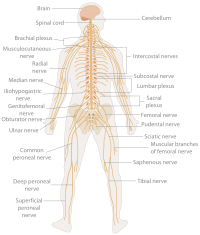
Photo from wikipedia
Allogeneic hematopoietic stem cell transplantation (alloHSCT) is a curative treatment for hematologic malignancies. Acute and chronic graft-versus-host disease (GvHD) are the major immune-mediated complications after alloHSCT. However, there is controversy… Click to show full abstract
Allogeneic hematopoietic stem cell transplantation (alloHSCT) is a curative treatment for hematologic malignancies. Acute and chronic graft-versus-host disease (GvHD) are the major immune-mediated complications after alloHSCT. However, there is controversy whether neurologic complications after alloHSCT might represent manifestations of GvHD. We report three patients who acquired distinct, severe immune-mediated peripheral or central nervous system diseases after alloHSCT without other, concomitant GvHD manifestations. One patient had been diagnosed with B-cell chronic lymphocytic leukemia and two patients with high risk myelodysplastic syndrome. Patient #1 presented as LGI1- and GAD-IgG positive immune-mediated encephalitis, patient #2 was diagnosed with MOG-IgG positive encephalomyelitis, and patient #3 had chronic inflammatory polyneuropathy associated with SSA(Ro)-IgG positive Sjögren’s syndrome. 100% donor chimerism was detectable in the peripheral blood in all three. The specific antibodies were undetectable in donors’ and patients’ blood before alloHSCT suggesting that the antibodies had arisen from the transplanted donor immune system. Early intensive immunotherapy led to improvement of clinical symptoms and stability of the neurological disease, however, at the cost of losing the graft-versus-malignancy effect in one patient. In conclusion, we provide evidence of isolated, severe allo-immune diseases of the peripheral and central nervous system as complications of alloHSCT (“neuro-GvHD”). Interdisciplinary surveillance and thorough diagnostic work-up are needed for early diagnosis and treatment of neuro-immunologic complications after alloHSCT to improve the otherwise poor outcome.
Journal Title: Scientific Reports
Year Published: 2021
Link to full text (if available)
Share on Social Media: Sign Up to like & get
recommendations!